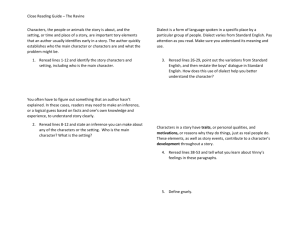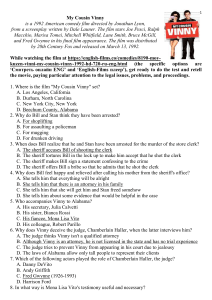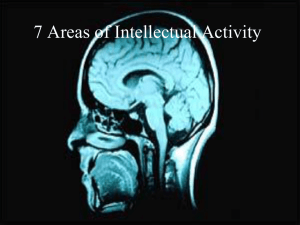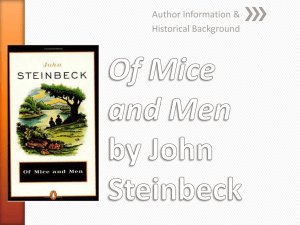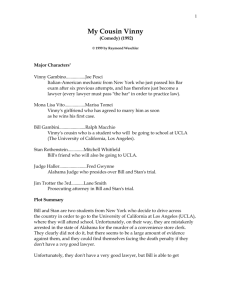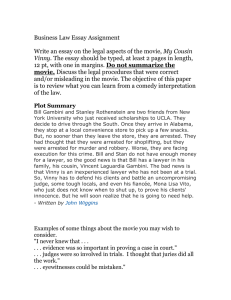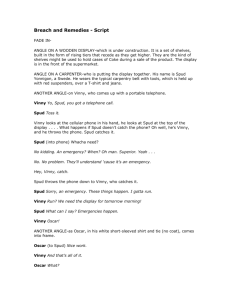Elmo visits Water Country
advertisement
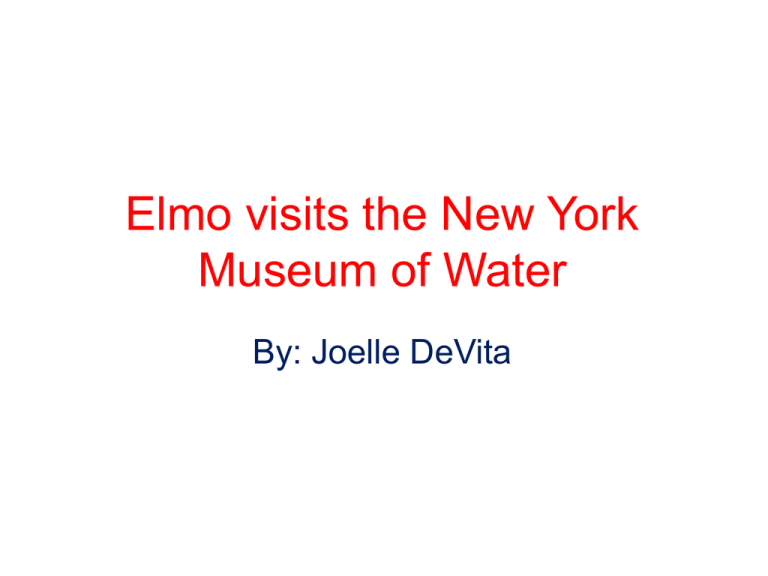
Elmo visits the New York Museum of Water By: Joelle DeVita One day, Elmo and his friends decided to take a field trip to New York’s Museum of Water Its time for our 1st field trip! They got on a bus and approached the museum. As they realized that unless they have a tour-guide, they wouldn’t understand the museum. So they found a tour-guide and started heading through the museum. The first exhibit they passed was about water molecules. Vinny, the tour guide, explained that the water molecule is made from 3 atoms. 2 hydrogen and 1 oxygen atom. He explained that because hydrogen and oxygen are non-metals, water is a covalent bond. “Hydrogen bonds form because water is polar. We will talk more about that later but hydrogen bonds are bonds that form easily and are very weak. Only little energy is needed to break these bonds.” 5 Let’s see what you’ve learned so far: 1) Water is what kind of bond? A) B) C) D) Ionic Helium Covalent Oxygen 2) What two atoms form a water molecule? A) Helium and oxygen B) Hydrogen and oxygen C) Calcium and sodium D) Hydrogen Correct answer: C Correct answer: B They also learned about cohesion and adhesion. “ Cohesion means working together.” said Elmo. “That’s a good way to think of it Elmo. Water cohesion means that water sticks to water, or that water works with itself. “Now, after knowing that, what do you think adhesion means?” Vinny asked. “Adhesion means that water sticks to other surfaces?” Big bird thought. “Right!” exclaimed Vinny. Now that you know what adhesion and cohesion means, let’s try a few examples. A) C) B) Both C) Cohesion A) Adhesion B) The next exhibit they went to was the use of water. Vinny told them about water being the Universal Solvent. Vinny made sure to tell everyone that “ Universal does not mean that water can dissolve everything, it simply means that water can dissolve a lot of different things.” “ What type of things?” asked Cookie Monster. “ Sugar, salt, coffee beans, tea bags…” “ Whoa! What doesn’t dissolve in water?” he asked. “Not many things” said Vinny. Water is known as the ______ solvent? A) B) C) D) Universal Soft Crunchy Purple Correct answer: A Which of the following was not listed as something that dissolves in water? A) B) C) D) Sugar Salt Tea Soda can Correct answer: D Next, Elmo learned about the water cycle. He learned that transpiration and evaporation are the first step of the cycle. He was also told that in order to start precipitation, or rain, you need to water evaporate. Vinny explained all the steps of the water cycle. First, evaporation and transpiration. Then, condensation and precipitation. And last but not least surface runoff. How many steps are there in the water cycle? A) B) C) D) 1 15 5 9 Correct answer: C In order for it to rain, what step of the water cycle needs to happen? A) B) C) D) Runoff Fog Smoke Evaporation and transpiration Correct answer: D After the use of water cycle, Elmo returned to water original exhibit. “ Next, we will be talking about waters surface tension.” Said Vinny. “Surface tension is the property of water that allows cohesion.” Said Vinny. “The molecules at the top of water are pulled inward causing internal pressure. This pressure causes a layer on top of water where things can stay still. This is what makes a water spider a water spider!” He told them. What causes water spiders able to stand on top of the water? A) B) C) D) Surface heat Surface tension Claws None of the above Correct Answer: B “ The next thing we are going to study is water’s density. Density is defined as weight per unit of volume. Water’s density is 1 g/ml. Anything more than 1 gram, will sink in water.” “Theres only one exception to this rule. That is that water in solid form will float on water. This rarely ever happens.” Vinny explained. Water in ____ form will Water has a density of _ g/ml? float on water? A)5 A) Liquid B) Hard C) Solid form D) Gas Correct answer: C) B)1 C)17 D)8 Correct answer: B) “ The next thing we’ll be learning about is capillary action and specific heat. Capillary action..” Vinny told. “ Is water’s ability to climb up the roots of plants. Or say, a paper towel.” “Water’s specific heat is the amount of energy needed to heat one gram of water by one degree Celsius. In other words, it’s the amount of energy needed to make water one degree hotter.” Water’s specific heat makes it hotter in Celsius. True or False? A) True B)False Vinny compared capillary action to what? A)A dog B) A person C) A pencil D) A paper towel Correct answer: A) Correct answer: D) “ The last thing that we are going to talk about is water’s polarity. Polarity means that water’s charge is not balanced. Oxygen is negative while hydrogen is positive.” Water molecule “ Thanks Vinny!” Fun Facts • • • • • It takes 2 gallons to brush your teeth. 25-50 gallons to take an average shower. The average person uses 80-100 gallons per day. 75% of the earths surface is water. The average person can only live a week without water. Bibliography http://www.nymw.org/about.html http://www.themarysue.com/wp-content/uploads/2011/04/sesamestreet.jpg http://nanopedia.case.edu/image/water%20molecule.JPG http://bioap.wikispaces.com/file/view/adhesion.jpg/107027229/adhesion.jpg http://scienceprojectideasforkids.com/wp-content/uploads/2010/05/adhesion-water-drops.jpg http://bioweb.uwlax.edu/bio203/2011/lehrer_brit/coheision%20and%20adhesion.jpg http://www.enchantedlearning.com/wgifs/Watercycle.GIF http://en.wikipedia.org/wiki/File:Surface_tension_March_2009-3.jpg http://www.sciencebuddies.org/science-fair-projects/project_ideas/PlantBio_img014.jpg http://farm4.static.flickr.com/3190/3058505609_b25efe1b94.jpg http://staff.jccc.net/pdecell/chemistry/water.gif http://www.njawwa.org/kidsweb/waterfacts/waterfacts.htm
